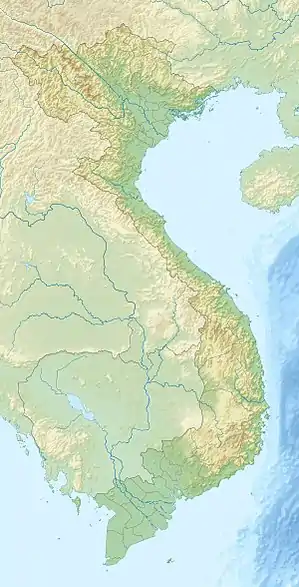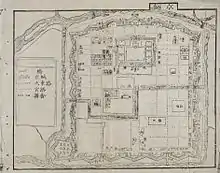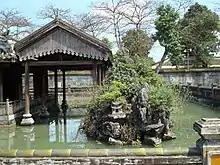Imperial City of Huế
The Imperial City (Vietnamese: Hoàng thành; Hán tự: 皇城) is a walled enclosure within the citadel (Kinh thành; 京城) of the city of Huế, the former imperial capital of Vietnam.

| UNESCO World Heritage Site | |
|---|---|
 | |
| Location | Huế, Vietnam |
| Part of | "Citadel of Huế, including Imperial City, Purple Forbidden City, Royal Canal, Museum of Huế, National University, Lake of the Serene Heart" part of Complex of Huế Monuments |
| Criteria | Cultural: (iv) |
| Reference | 678-001 |
| Inscription | 1993 (17th session) |
| Coordinates | 16°28′11″N 107°34′40″E |
 Location of Imperial City of Huế in Vietnam | |
History


In June 1789 Nguyễn Ánh ascended the throne of a unified Vietnam and proclaimed himself Emperor Gia Long with Hue, the ancestral seat of the Nguyen Lords as the capital. Geomancers were consulted as to the propitious location site for the new city and construction began in 1804. Thousands of workers were ordered to build the walled citadel and ringing moat, measuring some 10 kilometres (6.2 mi) long. The original earthwork was later reinforced and faced with brick and stone resulting in 2 m (6 ft 7 in)-thick ramparts.[1]
The citadel was oriented to face the Huong River (Perfume River) to the southeast. This differs from Beijing's Forbidden City in which faces true south. Rather than concentric rings centered on the Emperor's palace, the imperial residence itself is offset toward the southeast side of the citadel, nearer the river. A second set of tall walls and a second moat was constructed around this Imperial City, within which many edifices were added in a series of gated courtyards, gardens, pavilions and palaces. The entire complex was the seat of power until the imposition of the French protectorate in the 1880s. Thereafter it existed mostly to carry on symbolic traditions until the Nguyễn dynasty was ousted in 1945, with the Proclamation of Independence of the Democratic Republic of Vietnam. At the time, the Purple Forbidden City had many buildings and hundreds of rooms. Once vacated it suffered from neglect, termite ravages, and inclement weather including a number of cyclones. Nonetheless the Imperial City was an impressive sight. Most destructive were man-made crises as evidenced in the bullet holes still visible from the military conflicts of the 20th century.[1]
Major losses occurred in 1947 when the Việt Minh seized the Citadel in February. The French led counter-attack laid siege and the six-week ensuing battle destroyed many of the major structures. The core of the city including the Imperial Palace was burned.[2]
The Citadel came under fire again in the early morning hours of January 31, 1968, as part of the Tet Offensive a Division-sized force of People's Army of Vietnam and Viet Cong soldiers launched a coordinated attack on Huế seizing most of the city. During the initial phases of the Battle of Huế, due to Huế's religious and cultural status, U.S. troops were ordered not to bomb or shell the city, for fear of destroying the historic structures; but as casualties mounted in house-to-house fighting these restrictions were progressively lifted and the fighting caused substantial damage to the Imperial City.[3] Viet Cong troops occupied some portions of the citadel while South Vietnamese troops occupied others; and allied warplanes targeted the anti-aircraft guns the communists has mounted on the citadel's outer towers[4] Out of 160 buildings only 10 major sites remain because of the battle, such as the Thái Hòa and Cần Thanh temples, Thế Miếu, and Hiển Lâm Các. The city was made a UNESCO site in 1993. The buildings that still remain are being restored and preserved. The latest, and so far largest, restoration project is planned to conclude in 2015.[5]
Layout

.jpg.webp)
.jpg.webp)
The grounds of the Imperial City are protected by fortified ramparts 2 by 2 kilometres (1.2 by 1.2 mi), and ringed by a moat. The water in the moat is routed from the Perfume River through a series of sluice gates. This enclosure is the citadel (Kinh thành).
Inside the citadel is the Imperial City (Hoàng thành; 皇城), with a perimeter wall some 2.5 kilometres (1.6 mi) in length.
Within the Imperial City is the Purple Forbidden City (Tử cấm thành; 紫禁城), a term identical to the Forbidden City in Beijing. Access to the innermost enclosure was restricted to the imperial family.
Imperial City gates
- Cửa Đông Nam (Southeast Gate), also called cửa Thượng Tứ
- Cửa Chính Đông (East Gate) also called cửa Đông Ba
- Cửa Đông Bắc (Northeast Gate) also called cửa Trài or cửa Mang Cá nhỏ
- Cửa Chính Bắc (North Gate), also known as cửa Hậu or cửa Mang Cá lớn
- Cửa Tây (West Gate)
- Cửa Thể Nhân, popularly called cửa Ngăn
Purple Forbidden City main gates
- Ngọ Môn (午門) (south)
- Cửa Hòa Bình (和平門) (north)
- Cửa Chương Đức (彰德門) (west)
- Cửa Hiển Nhơn (顯仁門) (east)
Outer Court
- Điện Thái Hòa (太和殿)
- Điện Phụng Tiên (奉先殿)
- Cung Trường Sanh (長生宮)
- Cung Diên Thọ (延壽宮)
Temples and places of worship


- Triệu Miếu (肇廟)
- Thái Miếu (太廟)
- Hưng Miếu (興廟)
- Thế Miếu (世廟)
- Điện Phụng Tiên (奉先殿)
- Hiển Lâm Các (顯臨閣)
Inner Court
- Đại Cung môn (大宮門)
- Tả vu (左廡), Hữu vu (右廡)
- Điện Cần Chánh (勤政殿)
- Điện Võ Hiển (武顯殿)
- Điện Văn Minh (文明殿)
- Điện Trinh Minh (貞明殿)
- Điện Quang Minh (光明殿)
- Điện Càn Thành (乾成殿)
- Điện Khôn Thái (坤泰殿)
- Viện Thuận Huy (順徽院)
- Viện Dưỡng Tâm (養心院)
- Ngự Tiền Văn phòng (御前文房)
- Lục Viện (六院)
- Điện Minh Thận (明慎殿)
Gardens
- Vườn Ngự Uyển (紹芳園)
Pavilions
- Lầu Kiến Trung
- Thái Bình Lâu (太平樓)
Visiting hours
The Imperial City is open to the general public for viewing,.[6] Overseas visitors are required to pay an entry fee of 200,000 VND per person to enter.
| Day | Hours accessible to public |
|---|---|
| Monday | 8 am – 5:30 pm |
| Tuesday | 8 am – 5:30 pm |
| Wednesday | 8 am – 5:30 pm |
| Thursday | 8 am – 10 pm |
| Friday | 8 am – 5:30 pm |
| Saturday | 8 am – 5:30 pm |
| Sunday | 8 am – 5:30 pm |
References
- "The Citadel". hueworldheritage.org.vn.
- Perlez, Jane (February 16, 2004). "Hue Journal; Vietnam Slowly Restores Imperial City With a Grim Past" – via NYTimes.com.
- Shulimson, Jack; LtCol. Leonard Blasiol; Charles R. Smith; Capt. David A. Dawson (1997). U.S. Marines in Vietnam: 1968, the Defining Year. History and Museums Division, USMC. p. 205. ISBN 0-16-049125-8.
 This article incorporates text from this source, which is in the public domain.
This article incorporates text from this source, which is in the public domain. - https://wtop.com/asia/2018/01/ap-was-there-the-vietnam-wars-tet-offensive/slide/1/
- Vietnam to spend 61 million dollars to restore Hue royal citadel. Retrieved 2012-07-26.
- "Imperial City". www.imperialcityhue.com. Retrieved 2017-08-02.
External links
| Wikimedia Commons has media related to Citadel of Huế. |
- 5182931945 Imperial City of Huế on OpenStreetMap
.jpg.webp)
.gif)


